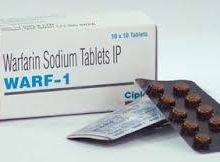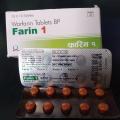Home / Categories / WARF-1MG

WARF-1MG
(10)
WARFARIN-1MG
ANTICOAGULANTS, ANTIPLATELETS & FIBRINOLYTICS
CIPLA India Limited
Product Details
WARFARIN
Description
Warfarin is an anticoagulant drug normally used to prevent blood clot formation as well as migration. Although originally marketed as a pesticide (d-Con, Rodex, among others), Warfarin has since become the most frequently prescribed oral anticoagulant in North America. Warfarin has several properties that should be noted when used medicinally, including its ability to cross the placental barrier during pregnancy which can result in fetal bleeding, spontaneous abortion, preterm birth, stillbirth, and neonatal death. Additional adverse effects such as necrosis, purple toe syndrome, osteoporosis, valve and artery calcification, and drug interactions have also been documented with warfarin use. Warfarin does not actually affect blood viscosity, rather, it inhibits vitamin-k dependent synthesis of biologically active forms of various clotting factors in addition to several regulatory factors.
Indication
For the treatment of retinal vascular occlusion, pulmonary embolism, cardiomyopathy, atrial fibrillation and flutter, cerebral embolism, transient cerebral ischaemia, arterial embolism and thrombosis.
Associated Conditions
- Myocardial Infarction
- Pulmonary Embolism (PE)
- Strokes
- Systemic Embolism
- Thromboembolism
- Thrombosis, Venous
- Transient ischemia attacks
Pharmacodynamics
Warfarin, a coumarin anticoagulant, is a racemic mixture of two active isomers. It is used in the prevention and treatment of thromboembolic disease including venous thrombosis, thromboembolism, and pulmonary embolism as well as for the prevention of ischemic stroke in patients with atrial fibrillation (AF).
Mechanism of action
Warfarin inhibits vitamin K reductase, resulting in depletion of the reduced form of vitamin K (vitamin KH2). As vitamin K is a cofactor for the carboxylation of glutamate residues on the N-terminal regions of vitamin K-dependent proteins, this limits the gamma-carboxylation and subsequent activation of the vitamin K-dependent coagulant proteins. The synthesis of vitamin K-dependent coagulation factors II, VII, IX, and X and anticoagulant proteins C and S is inhibited. Depression of three of the four vitamin K-dependent coagulation factors (factors II, VII, and X) results in decreased prothrombin levels and a decrease in the amount of thrombin generated and bound to fibrin. This reduces the thrombogenicity of clots.
Absorption
Rapidly absorbed following oral administration with considerable interindividual variations. Also absorbed percutaneously.
Volume of distribution
- 0.14 L/kg
Protein binding
99% bound primarily to albumin
Metabolism
Metabolized stereo- and regio-selectively by hepatic microsomal enzymes. S-warfarin is predominantly metabolized by cytochrome P450 (CYP) 2C9 to yield the 6- and 7-hydroxylated metabolites. R-warfarin is metabolized by CYP1A1, 1A2, and 3A4 to yield 6-, 8-, and 10-hydroxylated metabolites. Hydroxylated metabolites may be further conjugated prior to excretion into bile and urine. UGT1A1 appears to be responsible for producing the 6-O-glucuronide of warfarin, with a possibly contribution from UGT1A10. Five UGT1As may be involved in the formation of 7-O-glucuronide warfarin. S-warfarin has higher potency than R-warfarin and genetic polymorphisms in CYP2C9 may dramatically decrease clearance of and increase toxicity of the medication.
SOURCE: DRUGBANK

